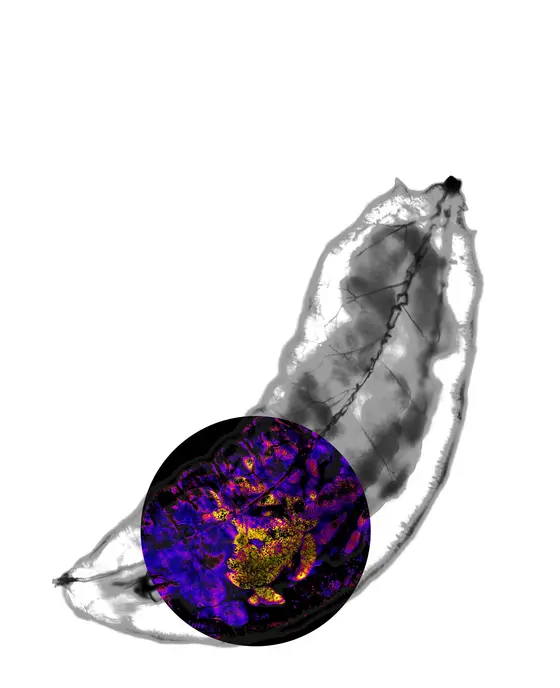Arterial calcification and coronary heart disease, neurodegenerative diseases such as Parkinson’s and Alzheimer’s, cancer and even the aging process itself are suspected to be partially caused or accelerated by oxidative stress. Oxidative stress arises in tissues when there is an excess of what are called reactive oxygen species (ROS). “However, up to now, nobody was able to directly observe oxidative changes in a living organism and certainly not how they are connected with disease processes," said Associate Professor (PD) Dr. Tobias Dick of DKFZ. “There were only fairly unspecific or indirect methods of detecting which oxidative processes are really taking place in an organism."
For the first time, Tobias Dick and his co-workers have been able to observe these processes in a living animal. Jointly with Dr. Aurelio Teleman (also of DKFZ), they introduced genes for biosensors into the genetic material of fruit flies. These biosensors are specific for various oxidants and indicate the oxidative status of each cell by emitting a light signal – in realtime, in the whole organism and across the entire life span.
In the fly larvae, the investigators already discovered that oxidants are produced at very differing levels in different tissue types. Thus, blood cells produce considerably more oxidants in their energy plants, the mitochondria, than, for example, intestinal or muscle cells. In addition, the larvae’s behavior is reflected in the production of oxidants in individual tissues: The researchers were able to distinguish whether the larvae were eating or moving by the oxidative status of the fat tissue.
Up to now, many scientists have assumed that the aging process is associated with a general increase in oxidants throughout the body. However, this was not confirmed by the observations made by the investigators across the entire life span of the adult animals. They were surprised that almost the only age-dependent increase in oxidants was found in the fly’s intestine. Moreover, when comparing flies with different life spans, they found out that the accumulation of oxidants in intestinal tissue even accelerated with a longer life span. The group thus found no evidence supporting the frequently voiced assumption that an organism’s life span is limited by the production of harmful oxidants.
Even though comprehensive studies have failed to provide proof until the present day, antioxidants are often advertised as a protection against oxidative stress and, thus, health-promoting. Dick and colleagues fed their flies with N-acetyl cysteine (NAC), a substance which is attributed an antioxidant effect and which some scientists consider suitable for protecting the body against presumably dangerous oxidants. Interestingly, no evidence of a decrease in oxidants was found in the NAC-fed flies. On the contrary, the researchers were surprised to find that NAC prompted the energy plants of various tissues to significantly increase oxidant production.
“Many things we observed in the flies with the help of the biosensors came as a surprise to us. It seems that many findings obtained in isolated cells cannot simply be transferred to the situation in a living organism," said Tobias Dick, summarizing their findings. “The example of NAC also shows that we are currently not able to predictably influence oxidative processes in a living organism by pharmacology," he adds. “Of course, we cannot simply transfer these findings from fly to man. Our next goal is to use the biosensors to observe oxidative processes in mammals, especially in inflammatory reactions and in the development of tumors."
Simone C. Albrecht, Ana Gomes Barata, Jörg Großhans, Aurelio A. Teleman and Tobias P. Dick: In vivo mapping of hydrogen peroxide and oxidized glutathione reveals chemical and regional specificity of redox homeostasis. Cell Metabolism 2011, DOI:10.1016/j.cmet.2011.10.010.
A picture for this press release is available on the Internet at:
Wandernde-Larve.jpg
Legend: Yellow light signals emitted by the biosensor indicate oxidant production in the tissue of a migrating fly larva.
Source: Tobias Dick, German Cancer Research Center



